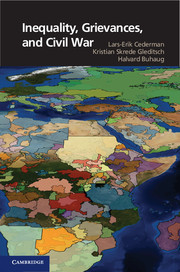Book contents
- Frontmatter
- Contents
- Tables
- Figures
- Preface
- 1 Introduction
- Part I Theories and concepts
- Part II Empirical analysis of civil war onset
- 4 Political Exclusion and Civil War
- 5 Economic Inequality and Civil War
- 6 Transborder Ethnic Kin and Civil War
- 7 Country-Level Inequalities and Civil War
- Part III Beyond civil war onset
- References
- Index
5 - Economic Inequality and Civil War
Published online by Cambridge University Press: 05 June 2014
- Frontmatter
- Contents
- Tables
- Figures
- Preface
- 1 Introduction
- Part I Theories and concepts
- Part II Empirical analysis of civil war onset
- 4 Political Exclusion and Civil War
- 5 Economic Inequality and Civil War
- 6 Transborder Ethnic Kin and Civil War
- 7 Country-Level Inequalities and Civil War
- Part III Beyond civil war onset
- References
- Index
Summary
Horizontal inequality concerns more than political power. Following Stewart (2008a), we have conceptualized it as a multidimensional concept in Chapter 3. Indeed, most studies of inequality evaluate the consequences of differences in wealth and income rather than in terms of political influence. As a complement to the previous chapter, we therefore continue our investigation of group-level effects by considering the impact of economic horizontal inequality.
Again, we are up against what is commonly perceived as a nonresult. As was shown in Chapter 2, the contemporary quantitative literature on civil war finds no evidence for a link between economic inequality and internal conflict. Based on indicators measuring individual wealth distributions, these studies find no statistically distinguishable relationship to internal conflict (e.g., Fearon and Laitin 2003; Collier and Hoeffler 2004). Yet, inequality continues to occupy a prominent place in the qualitative literature on civil wars and has repeatedly been linked to conflict processes (Wood 2003; Sambanis 2005, p. 323; Boix 2008; Stewart 2008a). Earlier research relying on the Minorities at Risk data link found that economically discriminated groups were more likely to mobilize or protest (see, e.g., Gurr 1993a; Goldstone et al. 2010). However, this line of research has tended to look at measures of political instability broader than civil war. Their claims about groups have been largely ignored by much of the conventional civil war literature, which has focused on countries rather than groups. Moreover, in the last few years, some quantitative studies of civil war have started to appear arguing that the current literature's failure to connect distributional asymmetries to conflict behavior may actually be due to inappropriate conceptualization and imperfect measurements, rather than reflecting a fundamental absence of any causal effect (Østby 2008b; see also Cramer 2006; Stewart 2008a).
- Type
- Chapter
- Information
- Inequality, Grievances, and Civil War , pp. 93 - 118Publisher: Cambridge University PressPrint publication year: 2013



